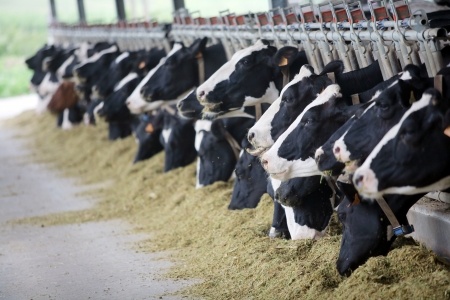
Average farm business incomes were up by nearly 50 per cent overall in the last financial year - and dairy units saw income soar by as much as 140 per cent.
Latest figures released by the DEFRA show that, in 2017-18, average farm business income increased for all farm types except for specialist pig farms.
The increases were partly driven by exchange rates leading to price rises for a number of commodities, according to the Defra report's authors. There was also an increase in the value of the Basic Payment.
The average Basic Payment in 2017-18 was £31,700 - a 13 per cent increase on the previous year. This was a result of the weaker pound in September 2017 when the exchange rate was determined.
Average income increased by 49 per cent year-on-year across all types of farms - from £38,000 in 2016-17 to £56,500 in 2017-18.
The biggest increase was in the dairy sector, where incomes more than doubled. Average business income was up by 140 per cent from £50,000 in 2016-17 to £119,700 in 2017-18.
Defra said that production increased by eight per cent on dairy farms. It said there was a rise in average dairy cow numbers and the average milk price was up 23 per cent to 29.6 pence per litre, although the report said there was a wide variation in milk prices. Some farmers received considerably more or less than the average.
Specialist poultry farms also enjoyed a good year, with average incomes up by 77 per cent to £96,000. Defra said output from eggs rose by seven per cent - driven by an increase in price.
However, it said this finding contrasted with UK statistics showing an increase in egg production and a small fall in prices.
Defra said there was an increase in output from birds for poultry meat, although it said the size of the increase should be treated with some caution as it was largely due to a change in the sample composition.
Increased cereal output
For farms that were in the sample in both years, there was a small increase in output. These rises were partially offset by increases to both variable and fixed costs, said Defra.
Average income on cereal farms was up 49 per cent - mainly because of increased output. Defra said a combination of higher prices for wheat and barley, driven by a weakening of Sterling, and increased average yields due to more favourable growing conditions resulted in a 13 per cent increase in crop output.
General cropping farms saw their incomes increase by 33 per cent last year to £93,300. Total crop output was 16 per cent higher than in 2016-17. This was largely driven by increased areas, yields and prices for wheat and increased oilseed rape and sugar beet production.
These increases were partially offset by a fall in the value of the 2017 potato crop - plentiful supplies due to higher yields and a rise in crop area resulted in lower prices.
On lowland grazing livestock farms, average income increased by 36 per cent to £21,900. Cattle output, the main revenue source for this farm type, increased as the exchange rate and tighter supplies led to higher prices for finished cattle.
Store prices were also higher than in 2016-17. Increased fat lamb prices helped to increase sheep output, said the Defra report.
Average income increased by 45 per cent to £41,800 on mixed farms. A 21 per cent increase in total farm business output was driven by higher crop and livestock output, together with a 20 per cent increase in the average Basic Payment.
Output from diversified activities was also higher, particularly for building rental, although revenue from food processing and retailing fell.
For farms in horticulture, income was up by nine per cent to £47,700. Overall, agricultural output remained at a similar level to the previous year, said Defra. Reduced output from potatoes, glasshouse flowers, bulbs and nursery stock and contract work on other farms offset increases from other crops.
Agricultural costs fell by one per cent. Output from diversified activities, an important source of revenue for horticulture farms, increased by four per cent, with food processing, retailing and building rental contributing most to the rise.
Average income on LFA grazing livestock farms increased by five per cent to £28,300. Farm business output rose by seven per cent due to increased output from agriculture, agri-environment schemes and a 13 per cent rise in the average Basic Payment. Sheep and cattle output were both higher than a year earlier.
Both sales and prices for fat lambs were higher than the previous year, whilst revenue from ewes and hoggs also increased despite prices being similar to or lower than the previous year.
Pig farm setback
The one sector where incomes fell back compared with 2016-17 was specialist pig farms. Average income was down by 46 per cent to £31,300. Agricultural output was two per cent lower, largely due to reduced crop output due to a lower tillage area.
Pig revenue increased by eight per cent in 2017-18 as lower throughput was offset by an increase in finished pig prices. However, there was a considerable fall in the closing valuation, as both pig prices and numbers were lower than at the beginning of the year. Both variable and fixed costs increased by three per cent.
The report's authors said that, whilst most types of farming saw an increase in average incomes last year, there was considerable variation in incomes from farm to farm.
They said that in 2017-18 at least 10 per cent of each farm type except dairy failed to make a profit. For dairy farms, four per cent failed to make a profit whilst 63 per cent had an income of more than £75,000.
